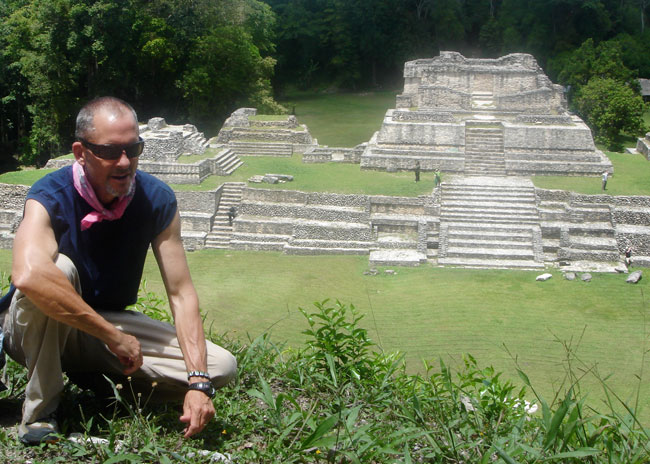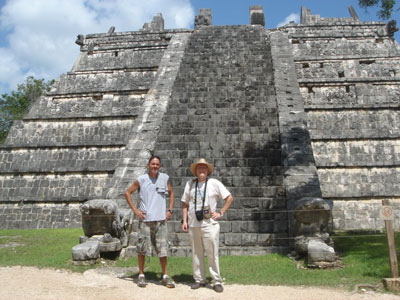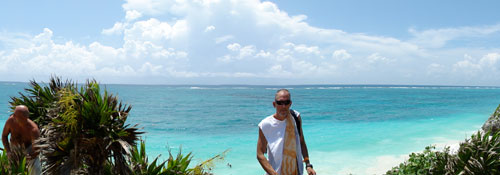History Prof Spends Summer 'Revisioning The Maya' Through Fellowship
Aug. 26, 2011
SHSU Media Contact: Jennifer Gauntt

Charles Heath is an assistant professor of history who has been teaching at SHSU since 2007. This semester Heath is teaching "History of Colonial Latin America," "History of Latin America" and the U.S. History Survey. In the spring, he will teach the newly state-approved " History of Modern Mexico." Below, he describes his experience as part of a National Endowment for the Humanities Summer Institute fellowship he participated in this summer.
 This summer I was awarded a fellowship for the National Endowment for the Humanities Summer Institute, "Revisioning the Maya," a five-week intensive interdisciplinary study and travel program in the Yucatan Peninsula and state of Chiapas in Mexico and in the jungles of Belize.
This summer I was awarded a fellowship for the National Endowment for the Humanities Summer Institute, "Revisioning the Maya," a five-week intensive interdisciplinary study and travel program in the Yucatan Peninsula and state of Chiapas in Mexico and in the jungles of Belize.
While the fellowship did not correspond directly to the focus of my research, an opportunity to better understand the history of Maya civilization improved my ability to teach its significance to my students of Latin American history.
What is it that so fascinates us about the Maya? Their sophisticated calendrics, advanced mathematical computations, their understanding of astronomy? How many misunderstandings are there of their culture and civilization? Did Maya civilization collapse? Did they predict an apocalypse for 2012? Did the Spanish annihilate them? Why are they less known and understood than, say, the Mesopotamians or Egyptians? Maya civilization outlasted each of those civilizations, built structures in size to rival either, and ranged more broadly geographically, and in much more inhospitable climates.
For five weeks I and 23 other fellows from around the United States traveled extensively through southern Mexico and Belize. We boarded a bus most mornings by 9 a.m., visiting more than two dozen ancient sites, the "youngest," Chichen Itza, being over a thousand years old. We were in the company of some of the greatest experts in field of Mayan studies, including Alfonso Morales, one of the archaeologists who discovered the tomb of King Pakal in Palenque; Bill Saturno, the archaeologist who discovered the largest murals found to date; Jaime Awe, director of the National Institute of Archaeology in Belize; Jeff Kowalski, the renowned Maya architectural historian; and Rach Cobos, a leading Yucatecan archaeologist; and many others. We combined on-site explorations with seminars, readings, and some good old-fashioned fun and camaraderie. It was my first time in the Maya regions, and I had no idea of the scope of their civilization, either in chronological time, extensive city-states, or the sheer richness of their works.
One of the most memorable excursions was an "Apocalypse Now" style riverboat ride, one and half-hours into the Belizean jungle to a site called Lamanai, or “Place of the Submerged Crocodile,” which was occupied for nearly 3,000 years. The site was enshrouded in a veritable black cloud of mosquitoes, the only respite found at the top of a high temple-style pyramid approximately 33 meters in height.
Another memorable afternoon was at the site of Edzna in Mexico, almost completely free of visitors, on top of a range-style edifice (center of second attachment). I was able to look out over the entire site, to enjoy the sheer immensity of the work, and to watch a storm roll in until I was forced to run back to the bus to escape the lightening.
 One of the most visited historical sites in Mexico, Tulum, has been modified to receive thousands of visitors on a daily basis who are shuttled in by bus from tourist sites like Cancun and Cozumel. All of the structures are roped off; it was one of the few sites we visited that you could not actually climb on the temples and pyramids, but there was something special there, too: the site is perched on the Caribbean Sea, and there is a staircase down to a small beach. We descended at noon on another extremely hot day, changed into our swimsuits and swam in the glimmering crystalline turquoise surf.
One of the most visited historical sites in Mexico, Tulum, has been modified to receive thousands of visitors on a daily basis who are shuttled in by bus from tourist sites like Cancun and Cozumel. All of the structures are roped off; it was one of the few sites we visited that you could not actually climb on the temples and pyramids, but there was something special there, too: the site is perched on the Caribbean Sea, and there is a staircase down to a small beach. We descended at noon on another extremely hot day, changed into our swimsuits and swam in the glimmering crystalline turquoise surf.
While most of the sites we visited have clearly been unoccupied for centuries, we did come into contact with many modern-day Maya who continue to enjoy a vibrant culture. Both of our guides, along with some of our invited speakers, were of Mayan descent and spoke their regional dialects. One of our last sessions was to listen to poets in the Maya language as they seek to reclaim that which the Spanish almost eradicated after conquest.
One of the recurring themes of the institute was the ongoing struggle of the modern-day Maya to find a space for their culture in a globalized world. One response was to broker a deal with the Mexican government that permits collectives to run the tourist trade on their traditional lands. We stopped one day at a site where we ate lunch and toured their accommodations including a restaurant, bungalows and crafts shops. The members of the collective staffed the restaurant themselves, and the cuisine was one of the trip’s highpoints. We dined upon vegetarian tamales in which the main ingredient, beside the corn grown on the collective, is an herb called “chaya.” Chaya is attributed with many healthy qualities, especially for gastric and circulatory health. The tamales also contained pumpkin seeds harvested on site.
The fellowship has inspired me, among other things, to adopt additional books on the Maya, including one about the so-called impending apocalypse of 2012 for my Colonial undergrad class next year (students will have to take the final if the world does not end in December 2012); to offer a graduate seminar on the history of maize, the food at the center of Mayan life, history and cosmovision; and to eventually lead a travel-abroad exploring the culture and civilizations of Mesoamerica. I also hope to present a travelogue of my trip and its ramifications for my teaching and scholarship at the college and university level this fall.
- END -
This page maintained by SHSU's Communications Office
Director: TBD
Assistant Director: Julia May
Writer: Jennifer Gauntt
Located in the 115 Administration Building
Telephone: 936.294.1836; Fax: 936.294.1834
Please send comments, corrections, news tips to Today@Sam.edu.

 SamWeb
SamWeb My Sam
My Sam E-mail
E-mail

